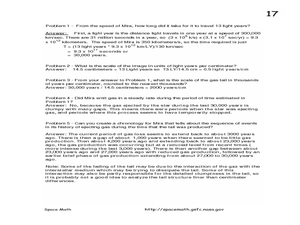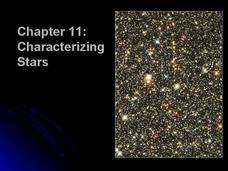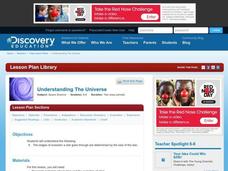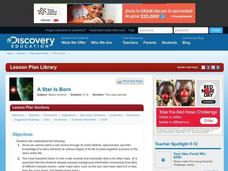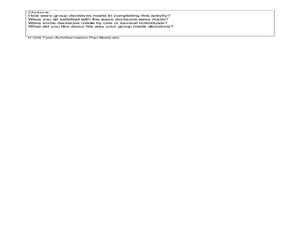Curated OER
The Wolf's Tale
In this the wolf's tale: pre-reading activities worksheet, 4th graders write a definition and ingredients of a fairy tale, then sort the characters in Little Red Riding Hood, match sentences from the story and write the ending.
Curated OER
Mars
After reading a short excerpt about the planet named after the Roman god of war, Mars, your class will answer four comprehension questions. The activity challenges them to fold over the paper and answer the questions without referring...
American Museum of Natural History
Mythic Creatures Challenge
Mythic creatures and where to find them is the subject of an engaging interactive resource. Young anthropologists click on a bright red X on a world map to see an image of and learn the stories of 15 legendary creatures.
Curated OER
Star Facts
Throughout the elementary grades students explore the galaxy. This simple presentation listing the types of stars could be used as a quick review of the information students have learned. It could be augmented with additional information.
Curated OER
Evolution of Stars
In this evolution of the stars worksheet, students are given 12 sentences and they choose from one of two terms to complete the sentences. They use a given diagram showing stars, their absolute magnitude and their spectral class.
Curated OER
A Star Sheds a Comet Tail!
For this comet tails and stars worksheet, high schoolers read about the star Mira and the vast clouds of gases it emits. They use a photograph from the Galaxy Evolution Explorer satellite to solve 5 problems about the scale of the image,...
Curated OER
Galaxies and Stars Scavenger Hunt
In this space worksheet, students identify and describe what auroras are in the sky and why they are made up of different colors. Then they explain why stars are born and what happens to them as they get older. Students also name which...
International Technology Education Association
Telescope as Time Machine
This resource provides an explanation of NASA's GALEX mission and how the space-based telescope can view distant galaxies as they were billions of years ago. The resource also discusses the other aspects of galaxies that GALEX is able to...
Curated OER
Exploring Stars
Fifth graders explore the life cycle of stars. They analyze small, medium, and large stars and view a video that compares the life cycles of the various sized stars. They create a flipbook movie detailing the life cycles of a star and...
Curated OER
Beyond Mendel's Laws of Inheritance
Mendels laws of Genetics are extended here with examples of traits that are completely controlled by just one gene. Malfunctions such as albinism and baldness can therefore be tracked and will demonstrate inheritance patterns to your...
American Museum of Natural History
What Do You Know About Stars?
Illuminate the information about stars. Pupils respond to 10 multiple choice questions about stars. The questions cover topics such as the size of the Milky Way Galaxy, the Sun, and the life cycle of a star. The resource works as a...
Glynn County School System
Lives and Deaths of Stars
Star light, star bright ... just how long can you wish on that star? Well, it depends on its mass. The presentation explains the life cycle of stars based on their sizes. Scholars learn about the life expectancy of a star based on the...
Curated OER
Lab Activity: Model of the Planets
This worksheet leads the class through the calculations needed to construct circles to represent the planets of our Solar System. The actual values are provided, as are suggested calculations to create the scale diameters. The ten...
Glynn County School System
Characterizing Stars
Are brighter stars actually brighter? Turns out they are probably just closer! A presentation compares features of stars to our favorite star, the sun. In addition, solar lovers learn to classify stars based on their masses,...
Mr. E. Science
Stars, Galaxies and the Universe
It takes 225 million years for our sun to travel around the galaxy. The presentation covers astronomical units, light years, telescopes, types of stars, the life cycle of a star, and types of galaxies. This is the last lesson in a...
Curated OER
Ending a Famous Fairy Tale
Altering the ending of a famous fairy tale is a really fun way for kids to experience creative writing. The instructional activity here has them do just that! Learners listen to the famous fairy tale, "The Twelve Brothers," and change...
Curated OER
The Universe
Middle schoolers recognize that the stages of evolution a star goes through are determined by the size of the star. They conduct research to draw a set of diagrams illustrating the stages in the evolution of three sizes of stars.
Curated OER
How is a Star's Color Related to Its Temperature?
For this star color and temperature worksheet, learners create a Hertzsprung-Russell diagram in order to determine how star brightness, color, temperature, and class are related. Once diagram is complete, they answer 6 short answer...
Curated OER
A Star is Born
Students research the life cycle of a star. In this astronomy lesson, students work in groups to research on stage in stellar evolution and report back to the class their findings. They will discuss as a class the order of the stages and...
Curated OER
Measuring Star Temperatures
For this measuring star temperatures, students find the temperature of a star using Planck's curve and the Wein Displacement law. Students also find the peak wavelengths for given stars using Planck's curve.
Curated OER
Teamwork and Challenge/ Challenge Activities
Learners work in teams to complete various movements. In this movement lesson plan, students listen, make decisions and act as leaders through a variety of physical activities.
Curated OER
Discover!
Young scholars design a double spiral mobile to illustrate the different stages in the life of a small-mass star like our Sun, and in the life of a large-mass star. They complete both spirals and create a small hole at the top. Next they...
Curated OER
Food Webs
Students investigate the concept of an ecosystem and how they are interconnected according to a hierarchy. Students are exposed to the "Lion King" as an example of a food chain and this is very relevant. They answer several key...
Curated OER
HOW SMALL AM I? THE SCIENCE OF NANOTECHNOLOGY
Students study nanotechnology and investigate the dimensions of a nanoscale. In this nanometer study instructional activity students will see how truly small a nanometer is by measuring things such as a piece of hair.







